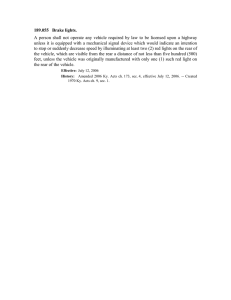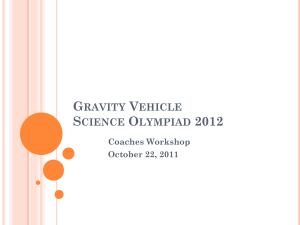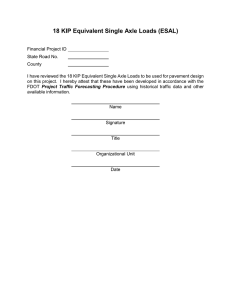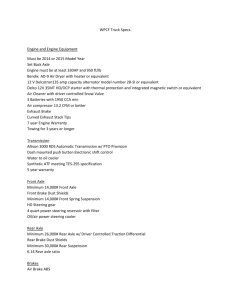Automotive Design
advertisement
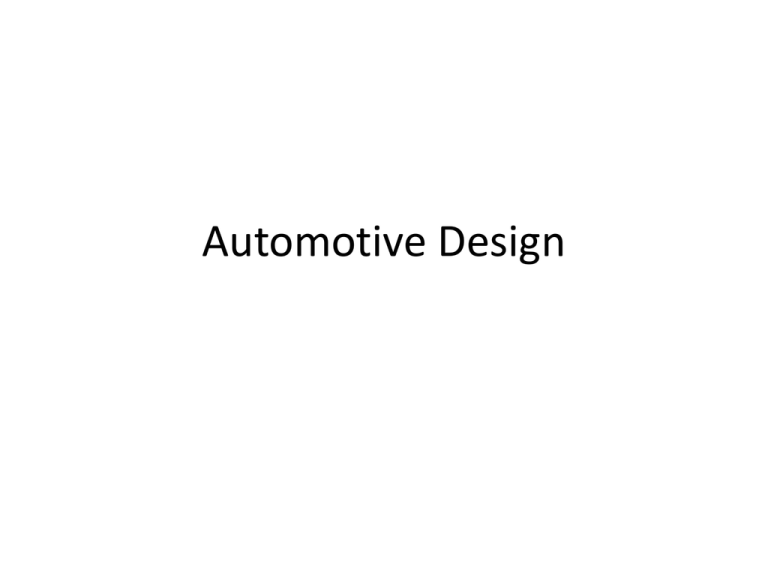
Automotive Design Braking System • 3 Requirements -decelerate in a controlled repeatable manner -help maintain constant speed down hill -hold vehicle stationary on a flat or on a gradient Should work in diverse conditions - Slippery, wet and dry roads Rough or smooth road Split friction surfaces Straight line braking or when braking on a curve Wet or dry brakes New or worn linings Laden or unladen vehicle Vehicle pulling a trailer or caravan Frequent or infrequent applications of short or lengthy duration - High or low rates of deceleration - Skilled or unskilled drivers Brake – Sub systems -Energy source (muscular effort vacuum boost/power braking/surge brakes / spring brakes) -Modulation System(to control brake force) -Transmission systems(brake lines/tubes, brake hoses(flexible tube),rods /livers/cams/cables etc. -Foundation brakes Four stages of Brakes system design -Fundamental stage -choice of force distributing between axles -Transmition System Design -sizing of master cylinder, rear & front wheel cylinders -Foundation system design -to apply loads & torque -thermal , wear & noise characteristics -Pedal assembly and vacuum boost system Vehicle parameters required for brake system design -Laden and unladen vehicle mass -Static weight distribution when laden and unladen -Wheelbase -Height of center of gravity when laden and unladen -Maximum vehicle speed -Tyre and rim size -Vehicle function -Braking standards Brake System Components & Configurations Pedal assembly Brake booster -to reduce manual pressure -vacuum booster(uses negative pressure in intake manifold Master cylinder -initiates & control braking -two separate braking circuits (primary & secondary) Contd.. -2 pistons in the same cylinder - If one system has a leak , the other takes care Regulating valves -when load transferred to the front , braking at rear need to be reduced 3 types -load sensitive(based on suspension displacement) -Pressure sensitive -Deceleration sensitive Contd.. Foundation brakes -Disc brakes/ Drum brakes -If both are discs , a small drum type parking brake also used Brake System Layout -2 variants-II & X Kinematics of Braking U2 St S1 S2 Ut1 2a U2 St S1 S2 Ut1 2a Contd.. Assumptions -instantaneous change in deceleration - no driver reaction time - no system response time - no deceleration rise time - no release time Typical Measured Deceleration time-history Driver reaction time t0-t1 -driver responds & move his foot to the pedal Initial system response time t1-t2 -up to start of breaking force at tyre Deceleration rise time -time to reach peak deceleration t2-t3 Breaking time t3-t4 -till vehicle stops Release time t4-t5 -brake release starts to end of brake force Stopping time t0-t4/t5 Braking time t1-t4/t5 Contd.. Kinematics of braking S1=U(t1-t0) S2=U(t2-t1) Contd.. Stopping distance Braking distance Kinematics of Braking For maximum deceleration -both axles should be on verge of lock simultaneously - If d> g , µ> 1.0 (depends on tyre compound) Retardation force -Primarily foundation braking - Rolling resistance (=0.01g) - Aerodynamic drag(proportional to at high speed) =0.03g - gradient(uphill/down hill) - Drivetrain drag - can contribute to the braking effort or use brake torque Tyre-road friction -Brake force(and hence torque) can not increase unbounded -limited by tyre road friction -depends on tyre & road surface and road condition -dry clean road 0.8<µ<1 -icy surfaces 0.05≤µ≤0.1 -wet surfaces contaminated by dirt 0.2≤µ≤0.65 Mechanism of friction -Adhesion(intermolecular bonds between rubber & surfaces) -hysteresis - energy loss during rubber deformation during slip v r -both rely on slip v Friction depends on slip -adhesion & hysteretic phenomenon increase with slip up to 20% slip -if slip> 20% , µb decreases -lateral brake force during turning depend on slip angle -lateral forces minimum when wheel is locked Brake Proportioning • If rear and front braking is not apportioned – Insufficient deceleration – Front axle lock (lack of steering control) – Rear axle lock (instability) – In either case – incomplete utilization of available friction (road adhesion) load transfer during braking • A variable brake effort ratio is required to provide ideal braking. • Factors – – – – – – Change in vehicle weight; Change in weight distribution; The effect of gradients (positive and negative); Cornering, (also lateral forces); Varying road surfaces and weather conditions; Split friction surfaces where the coefficient of adhesion changes from front to rear Effect of constant brake ratio Md T f Tr Mgz Tf Tr Pz My Fy Rr R f Mg 0 I M cg R f a Rr b Tf h Tr h 0 Mgb h T f Tr l l Mga h Rr T f Tr l l Rf Pzh l Pzh Rr Fr l R f Ff If front axle locks first (fixed brake ratio) Pzh T f R f Ff l • Consider brake ratio R • Rear Brake force • Total Brake force Pzh 1 T Pz Ff l xf Tr T f R xf xr Tr xr Pzh xr Ff xf l xf T Pz T f Tr OR Tf Pzh Pzh xr Ff Ff l l xf Pzh Tx f Ff l • Maximum braking deceleration z l Ff P lx f h Similarly, if the rear axle locks first • Deceleration if rear axle locks first l Fr z P lxr h Bra ke for ce/ veh icle wei ght (kN /P) 1.00 0.90 0.80 0.70 0.60 0.50 0.40 0.30 0.20 0.10 Tf P xf z Pzh Tx f Ff l a Tf/P TXf/P Tr/P Txr/P Tr xr z P b 0.00 0.0 0.2 0.4 0.6 0.8 Deceleration (g) 1.0 • Txf/r ---- Available braking force • Tf/r ------ Total Braking force 1.2 Txr Pzh Fr P P l Which wheel locks first? • Depends on which z is lower (at a or at b)? • Once one wheel locks, adhesion utilization is not complete • Enough brake force not generated by tyres Brake efficiency • If front axle locks l Ff P lx f h Ff h P xf l • If rear axle locks l Fr P lxr h Fr h P xr l z Graph of Efficiency, • Before point ‘a’, front axle lock happens • After that Rear axle lock happens • In both cases falls 1.2 0 1.1 Br aki ng effi cie nc y 51.1 0 1.0 a 5 1.0 0 0.9 5 0.9 00.8 50.8 0 0.7 50.7 0 0 100% Rear Fron t axle lock 0. 0. 0. Tyre-ground adhesion 2 4 6 coefficient axle Rear axle lock 0. 8 Front axle 1. 0 Deceleration vs adhesion • To the right of ‘a’, during rear axle lock, efficiency is low • Similarly to the right 1.2 1.0 De cel 0.8 era tio 0. ng 6 Front axle lock a 0. 4 0. 2 Optimum Front axle Rear axle Rear axle lock 0 0 0. 0. 0. adhesion 2 Tyre-ground 4 6 coefficient 0. 8 1. 0 Adhesion utilization • • • Adhesion utilization, f, is the theoretical coefficient of adhesion required to act at the tyre– road interface of a given axle for a particular value of deceleration. the minimum tyre– ground adhesion to sustain a given deceleration ratio of the braking force to the vertical axle load during braking. For the front of the vehicle the adhesion utilization is defined by ff Tf Rf x f Pz Pzh Ff l Similarly, for the rear of the vehicle fr Tr xr Pz Rr F Pzh r l • • • • • • • • • • The optimum line --- unit gradient defines the ideal adhesion utilization brake system remains 100% efficient over all possible values of deceleration. K limit -- The upper limit on allowable adhesion utilization, defined in the EEC Braking Directive, remaining two lines define the axle adhesion characteristics for the vehicle. The point labelled a, ----- both axles are on the verge of lock. At other points --- axle having the highest adhesion utilization coefficient limits the braking performance braking is limited by front axle lock up to a deceleration of 0.52g. Thereafter braking is limited by rear axle lock. It is also possible to find from this diagram the maximum deceleration for a given coefficient of adhesion utilization. Adhesion utilization, datum prototype vehicle • does not meet the required standard • front axle adhesion curve does not lie above that of the rear axle for all values of deceleration between 0.15g and 0.8g. • Change brake ratio in favour of the rear axle • point a to move up the optimum adhesion line. • The limiting deceleration is set at 0.8g x 0.803 • new brake ratio of x 0.197 . • Gives a modified adhesion diagram Adhesion utilization, modified prototype vehicle f r Brake system efficiency of modified prototype vehicle with variable brake ratio Adhesion utilization diagram for a category M1 vehicle • For category M1 vehicles, • • adhesion utilization of the front axle must be greater than that of the rear for all load cases and deceleration between 0.15g and 0.8g. • Between deceleration levels of 0.3g and 0.45g, an inversion of the adhesion utilization curves is allowed • provided the rear axle adhesion curve does not exceed the line defined by k = z by more than 0.05. • applicable within the area defined by the lines k = 0.8 and z = 0.8. • ensures that the rear wheels do not lock in preference to the front wheels and • proportion of braking effort exerted at the front of the vehicle is limited • the braking system does not become too inefficient. Front axle lock & vehicle stability • Lateral disturbance: side force Fy due to gradient, sidewind or left to right brake • Resultant force FR due to inertia force Fx and lateral force Fy causes a slip angle α. • FR is the direction in which the vehicle centre of gravity is moving. • Lateral force Fy balanced by side forces generated at the tyre – Front axle is locked ---- no side force at the front wheels – Side force is developed solely by the rolling rear wheels. – Gives rise to a total moment of Srb. • This yaw moment has a stabilizing effect – longitudinal axis aligns with the CG direction – reduces the initial slip angle α. • when the front axle is locked, – vehicle cannot respond to any steering inputs Rear axle lock and vehicle stability • In rear axle lock – The torque is detabilizing – Causes uncontrolled yaw • Vehicle should always have a preferred front axle lock • Choose fixed brake ratio such that for =1, both axles lock together at 1g Ph xf l xr F Ph r l Ff • Shall ensure front axle lock on all surfaces
